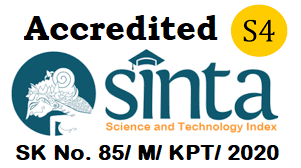Educative and Persuasive Trash Bin Design Builds Environmental Friendly Character for Early Childhood
Abstract
The development of educative and persuasive trash design in this study is one of the efforts in early childhood education (golden age), to form the foundation of environmental love character and awareness of disposing of garbage from an early age which is very necessary to be carried to adulthood. As one of the effort to support government programs ini shaping the character attitude and quality of life of human resources, which eventually arises awareness and is willing to move as an effort to preserve, improve and become a long-term environmental safety. To make the design of educative and persuasive trash bins, it is necessary to find the consumer's perception of the object under study, using the Conjoint analysis method. Determination of specific attributes (stimuli) in the development of characteristic specifications divides the concept of education in outline three factors namely auditory, kinestation, visual and developed in several variables. shape: other, design: character, audio: long (10-30 seconds), kinesthetic: automatic.

This work is licensed under a Creative Commons Attribution-NonCommercial-ShareAlike 4.0 International License.












